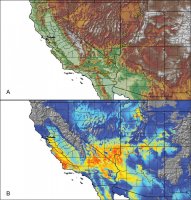- Joined
- Aug 8, 2016
- Messages
- 2,078
Finally saw my first bear. Out in the wilderness after so many trips seeing so much scat/fur/tracks? Haha, no. Four blocks from home at my morning running trail...
View attachment 57908
Great shot!
Follow along with the video below to see how to install our site as a web app on your home screen.
Note: This feature may not be available in some browsers.
Finally saw my first bear. Out in the wilderness after so many trips seeing so much scat/fur/tracks? Haha, no. Four blocks from home at my morning running trail...
View attachment 57908
Did it accentuate your running speed?Finally saw my first bear. Out in the wilderness after so many trips seeing so much scat/fur/tracks? Haha, no. Four blocks from home at my morning running trail...
View attachment 57908
Did it accentuate your running speed?
Beautiful! (...she says trying to convince herself...)
Snakes are OK by me, but I'll never get used to big spiders like this guy, though they don't bother me as much if they're outside. Where did you take the photo? I hope nowhere close to W. Colorado, though I have seen tarantulas down in the southwest corner of the state, though not this big.
I'd imagine they're in western CO at least a bit. We have a fair amount of Aphonopelma iodius (I think that's the species) up around SLC.Beautiful! (...she says trying to convince herself...)
Snakes are OK by me, but I'll never get used to big spiders like this guy, though they don't bother me as much if they're outside. Where did you take the photo? I hope nowhere close to W. Colorado, though I have seen tarantulas down in the southwest corner of the state, though not this big.

I'd imagine they're in western CO at least a bit. We have a fair amount of Aphonopelma iodius (I think that's the species) up around SLC.
I was curious, so I did some rudimentary research. Here's a heat map for the tarantula genus with the following description: "A distribution of known specimens B predicted distribution; warmer colors (red, orange, yellow) represent areas of high probability of occurrence, cooler colors (blue shades) represent areas of low probability of occurrence."
Looks kind of chilly. That's an unusual photo, as you don't see too many pictures of them swimming like that.Not backcountry, but a nice wildlife shot for me. Bison crossing the Lamar, just downstream of its confluence with Soda Butte Creek.
I'd imagine they're in western CO at least a bit. We have a fair amount of Aphonopelma iodius (I think that's the species) up around SLC.
I was curious, so I did some rudimentary research. Here's a heat map for the tarantula genus with the following description: "A distribution of known specimens B predicted distribution; warmer colors (red, orange, yellow) represent areas of high probability of occurrence, cooler colors (blue shades) represent areas of low probability of occurrence."
View attachment 58093
Right here. It's a pretty long article!Cooowelllll! Reference?
Sometimes it's the smallest things that can be the most inspirational.
Thank you sir! And this looks like a very valuable reference. Off to distraction....Right here. It's a pretty long article!
nimals, very much like this, strange and seemingly impossible, roamed the earth for aeons and then extincted on a dead-end path of the evolution of life here on earth. Greatly Recommended.
Don't like ads? Become a BCP Supporting Member and kiss them all goodbye. Click here for more info.
